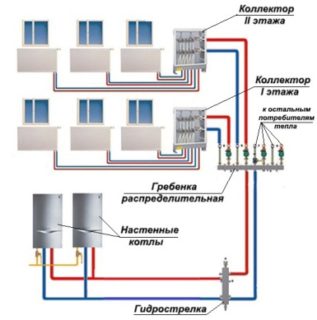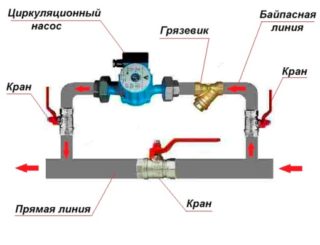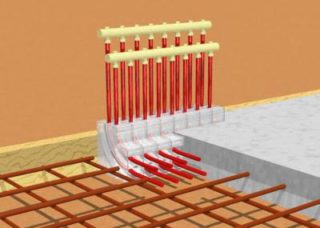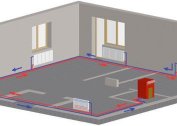There is a fairly wide variety of autonomous heating systems that are designed to heat private homes. In places where regular power outages are observed or the gas main does not pass nearby, people prefer traditional Russian stoves. This is the most striking example of a radiant heating system of a private house.
Modern radiant heating
Russian stoves are quite large, which sometimes creates difficulties in their installation in country houses, and even more so in city apartments. However, technology does not stand still, heating systems are modified and adapted to the needs of a modern person.
By connecting pipes from the collector to the radiators, the systems are divided into three types:
- radiation;
- two-pipe;
- single tube.
The principle of operation of radiant heating is based on the fact that the wiring is implied separately for each radiator. This is the most significant advantage of this system. If necessary, the radiators can be turned on and off as a group or individually.
The system is equipped with a special heat supply valve. If the street is warm or household appliances are working in the kitchen, the valve can be tightened a little. Thanks to the ability to regulate the flow of heat into the rooms, it is possible to save fuel.
Features and segments of beam wiring
The heating system, the operation of which is based on radiation, is most suitable for use in apartment buildings or country / private houses with several floors and a large number of rooms. This allows you to increase the efficiency of the entire heating system, guarantees high-quality heat supply and economically require a resource.
The principle of operation of the radiant heating system is simple, but has its own characteristics. If the structure has several floors, collectors should be installed on each. Moreover, in some cases it is advisable to install not one, but several collectors on the floor, and pipe them from them. The effectiveness of the equipment will be undeniable if the house is well insulated and heat loss is minimal.
The radiant heating system includes several basic elements necessary for quality work.
- The boiler is the main part. Heat is supplied from it to the pipes, and from there to radiators.
- Circular pumping station, due to which the necessary pressure in the pipes is provided and the coolant circulates.
- The collector, with the help of which uniform supply and distribution of heat is carried out in all rooms.
Another component is the closet. It manages to hide the distribution manifold, valves and pipes. The design is simple, practical and functional.
Beam heating circuit
In search of the most optimal type of heating scheme, they most often prefer a beam floor wiring of the pipeline. The essence of the method is that all pipes and accessories are hidden in the thickness of the floor. The main distribution organ of the system is mounted in a niche of a wall fence or in a special cabinet.
To implement the wiring diagram, you need a circular pump or several devices that are mounted on each branch or ring. Most often, this scheme is implemented on the basis of one- and two-pipe installation, displacing the tee connection method.
Near the riser of the two-pipe system, the supply and return manifolds are installed.From them, pipes are laid under the floors to each radiator installed on the floor.
Each of the circuits should approximately have the same length. If for some reason this cannot be realized, the large circuit must be separately equipped with a circular pump, automatic equipment for temperature control.
In this case, the temperature indicators on each circuit will be independent of each other. This is due to the fact that the pipeline will be under the screed. Each radiator is additionally equipped with an air tap. Air vents are usually mounted on a manifold.
Before starting work, you need to determine the location of the equipment, make a paper list of everything you need and schematically depict the location of the selected radiators.
Radiant heating system and underfloor heating
The radiant heating system and the underfloor heating are mounted in a similar way. Underfloor heating can be connected to radiators through one collector. This approach is extremely popular among people who want to insulate floors in some rooms, and not throughout the living space.
It is extremely important to provide for temperature control, otherwise the room may be too hot or cold. When organizing a warm floor, pipes must be insulated in one layer. Insulation material with a thickness of 6-10 mm transmits no more than 30% of the heat.
Advantages and disadvantages
The collector-beam heating system has incorporated all the advantages of its predecessors, which is due to the popularity of the equipment.
Main advantages:
- Aesthetics.
- From a hydraulic point of view, this is the most advanced heating system. Individual lines are drawn to each battery, so the system segments are independent.
- If desired or necessary, you can turn off any battery.
- All radiators receive water of the same temperature.
- It is possible to equip the system with automatic regulation and control as a whole by the whole circuit.
- The minimum number of connections, any tees are missing.
The most significant drawback is the high cost of equipment and its installation. Costs of expensive collectors and increased pipeline footage cannot compensate for the lack of fittings. If the building has several floors, the cost of equipment doubles, triples, etc., depending on the number of floors. Installation under the floors itself in the future involves additional work on the device flooring.
Modernization of any radiation system does not have special difficulties; for its implementation, installation of additional valves with a thermostatic head on each radiator that is connected to the system will be required. Thanks to the thermostat, it is possible to set the most optimal temperature regime in a particular case. The temperature will not rise above the parameters set by the person.
It is advisable to upgrade the heating system in those buildings where each room is delimited by purpose. For example, to store goods you need one temperature range, and for a comfortable stay in a room people are already different.
In search of the most suitable heating system, it is usually found out that the radiation system is best suited, since it has much more advantages than disadvantages. The latter rests only on finances, efficiency and system performance at the same time at an altitude. The average life of heating equipment is 50 years.






